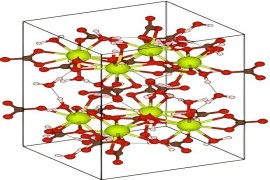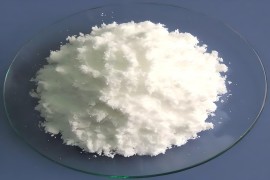Cerium carbonate is an inorganic compound produced by reacting cerium oxide with carbonate. It possesses excellent stability and chemical inertness and is extensively utilized in various sectors such as nuclear energy, catalysts, pigments, glass, etc. According to market research institutions' data, the global cerium carbonate market reached $2.4 billion in 2019 and is projected to reach $3.4 billion by 2024. There are three primary production methods for cerium carbonate: chemical, physical, and biological. Among these methods, the chemical method is predominantly employed due to its relatively low production costs; however, it also poses significant environmental pollution challenges. The cerium carbonate industry exhibits vast development prospects and potential but must also confront technological advancements and environmental protection challenges. UrbanMines Tech. Co., Ltd., a leading enterprise in China specializing in research & development as well as production & sales of cerium carbonate products aims to promote sustainable industry growth through intelligent prioritization of environmental protection practices while implementing high-efficiency measures intelligently. The UrbanMines’ R&D team has compiled this article to respond to our customer's questions and concerns.
1.What is cerium carbonate used for? What are the applications of cerium carbonate?
Cerium carbonate is a compound composed of cerium and carbonate, primarily utilized in catalytic materials, luminescent materials, polishing materials, and chemical reagents. Its specific application areas include:
(1) Rare earth luminescent materials: High-purity cerium carbonate serves as a crucial raw material for preparing rare earth luminescent materials. These luminescent materials find extensive usage in lighting, display, and other fields, providing essential support for the advancement of the modern electronic industry.
(2) Automobile engine exhaust purifiers: Cerium carbonate is employed in manufacturing automobile exhaust purification catalysts that effectively reduce pollutant emissions from vehicle exhausts and play a significant role in improving air quality.
(3) Polishing materials: By acting as an additive in polishing compounds, cerium carbonate enhances the brightness and smoothness of various substances.
(4) Colored engineering plastics: When used as a coloring agent, cerium carbonate imparts specific colors and properties to engineering plastics.
(5) Chemical Catalysts: Cerium carbonate finds wide-ranging applications as a chemical catalyst by enhancing catalyst activity and selectivity while promoting chemical reactions.
(6) Chemical reagents and medical applications: In addition to its use as a chemical reagent, cerium carbonate has demonstrated its value in medical fields such as burn wound treatment.
(7) Cemented carbide additives: The addition of cerium carbonate to cemented carbide alloys improves their hardness and wear resistance capabilities.
(8) Ceramic Industry: The ceramic industry utilizes cerium carbonate as an additive to enhance the performance characteristics and appearance qualities of ceramics.
In summary, due to its unique properties and a broad range of applications across various industries, cerium carbonates play an indispe.
2. What is the color of cerium carbonate?
The color of cerium carbonate is white, but its purity may slightly affect the specific color, resulting in a slight yellowish tint.
3. What are 3 common uses of cerium?
Cerium has three common applications:
(1) It is utilized as a co-catalyst in automobile exhaust purification catalysts to maintain the oxygen storage function, enhance catalyst performance, and reduce the usage of precious metals. This catalyst has been widely adopted in automobiles, effectively mitigating pollution from vehicle exhaust emissions to the environment.
(2) It serves as an additive in optical glass to absorb ultraviolet and infrared rays. It finds extensive use in automotive glass, providing protection against UV rays and reducing car interior temperature, thereby saving electricity for air conditioning purposes. Since 1997, cerium oxide has been incorporated into all Japanese automotive glass and is also extensively employed in the United States.
(3) Cerium can be added as an additive to NdFeB permanent magnet materials to enhance their magnetic properties and stability. These materials are widely applied in electronics and electrical machinery such as motors and generators, improving equipment efficiency and performance.
4. What does cerium do to the body?
The effects of cerium on the body primarily involve hepatotoxicity and osteotoxicity, as well as potential impacts on the optic nervous system. Cerium and its compounds are detrimental to the human epidermis and optic nervous system, with even minimal inhalation posing a risk of disability or life-threatening conditions. Cerium oxide is toxic to the human body, causing harm to the liver and bones. In daily life, it is crucial to take proper precautions and avoid inhaling chemicals.
Specifically, cerium oxide can reduce prothrombin content rendering it inactive; inhibit thrombin generation; precipitate fibrinogen; and catalyze phosphate compound decomposition. Prolonged exposure to items with excessive rare earth content can result in hepatic and skeletal damage.
Additionally, polishing powder containing cerium oxide or other substances can directly enter the lungs through respiratory tract inhalation leading to lung deposition potentially resulting in silicosis. Although radioactive cerium has a low overall absorption rate in the body, infants have a relatively high fraction of 144Ce absorption in their gastrointestinal tracts. Radioactive cerium primarily accumulates in the liver and bones over time.
5. Is cerium carbonate soluble in water?
Cerium carbonate is insoluble in water but soluble in acidic solutions. It is a stable compound that does not change when exposed to air but turns black under ultraviolet light.
6.Is cerium hard or soft?
Cerium is a soft, silvery-white rare earth metal with high chemical reactivity and a malleable texture that can be cut with a knife.
The physical properties of cerium also support its soft nature. Cerium has a melting point of 795°C, a boiling point of 3443°C, and a density of 6.67 g/mL. Additionally, it undergoes color changes when exposed to air. These properties indicate that cerium is indeed a soft and ductile metal.
7. Can cerium oxidise water?
Cerium is capable of oxidizing water due to its chemical reactivity. It reacts slowly with cold water and rapidly with hot water, resulting in the formation of cerium hydroxide and hydrogen gas. The rate of this reaction increases in hot water compared to cold water.
8. Is cerium rare?
Yes, cerium is considered a rare element as it constitutes approximately 0.0046% of the earth's crust, making it one of the most abundant among the rare earth elements.
9. Is cerium a solid liquid or gas?
Cerium exists as a solid at room temperature and pressure conditions. It appears as a silver-grey reactive metal that possesses ductility and is softer than iron. Although it can be transformed into liquid under heating conditions, at normal circumstances (room temperature and pressure), it remains in its solid state due to its melting point of 795°C and boiling point of 3443°C.
10. What does cerium look like?
Cerium exhibits the appearance of a silver-grey reactive metal belonging to the group of rare earth elements (REEs). Its chemical symbol is Ce while its atomic number is 58. It holds the distinction of being one of the most abundant REEs.Ceriu powder has high reactivity towards air causing spontaneous combustion, and also easily dissolves in acids. It serves as an excellent reducing agent primarily used for alloy production.
The physical properties include: density ranges from 6.7-6.9 depending on crystal structure; melting point stands at 799℃ while boiling point reaches3426℃. The name "cerium" originates from the English term "Ceres", which refers to an asteroid. The content percentage within Earth's crust amounts to approximately0.0046%, rendering it highly prevalent among REEs.
Ceriu mainly occurs in monazite, bastnaesite, and fission products derived from uranium-thorium plutonium. In industry, it finds wide applications such as alloy manufacturing catalyst utilization.






